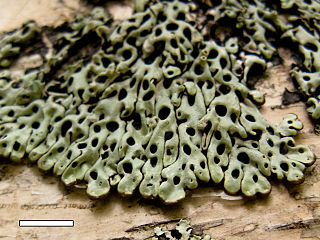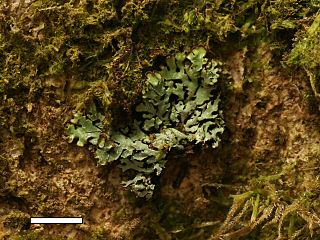
Menegazzia is a genus of lichenized fungi containing roughly 70 accepted species. The group is sometimes referred to as the tree flutes, honeycombed lichens, or hole-punch lichens. The most obvious morphological feature of the genus is the distinctive perforations spread across the upper side of the thallus. This makes the group easy to recognise, even for those not particularly familiar with lichen identification.
Menegazzia aucklandica is a species of foliose lichen from New Zealand. It was described as new to science by David Galloway and Peter James in 1983.
Menegazzia caliginosa is a species of foliose lichen from New Zealand, Australia and South America.
Menegazzia dielsii is a species of foliose lichen from New Zealand. It was first formally described by German lichenologist Johannes Hillmann in 1940. Rolf Santesson transferred it to the genus Menegazzia in 1943. It contains several lichen products: atranorin, conpsoromic acid, echinocarpic acid, and psoromic acid.

Menegazzia eperforata is a species of foliose lichen found in New Zealand and Australia.
Menegazzia foraminulosa is a species of corticolous (bark-dwelling), foliose lichen that is endemic to New Zealand. The lichen was first formally described as a new species in 1876 by August von Krempelhuber. Friedrich Bitter transferred it to the genus Menegazzia in 1901. The species contains several lichen products, including depsides, depsidones, as well as fatty acids and pigments.
Menegazzia globulifera is a species of foliose lichen found in New Zealand, Australia, and southern South America. It was formally described as a species new to science in 1942 by Swedish lichenologist Rolf Santesson. The type specimen was collected north of Lago Fagnano. The lichen is typically encountered as an epiphyte, but occasionally it has been recorded growing on rocks. Menegazzia globulifera contains usnic acid and lecanoric acid as major lichen products.
Menegazzia hypernota is a species of foliose lichen found in Australasia. It was formally described as a new species in 2004 by Jarle Bjerke from specimens collected in New Zealand. The lichen contains fumarprotocetraric acid as the major lichen product in the medulla. Menegazzia hypernota was reported from Tasmania in 2019.
Menegazzia inactiva is a species of foliose lichen found in New Zealand and Australia. The type locality of this species is in Tasmania, south of Arthur River near Sumac Road. The species was discovered on Tasmannia lanceolata in rainforest habitat. The type specimen is held at the herbarium of the Tasmanian Museum and Art Gallery.
Menegazzia inflata is a species of foliose lichen found in New Zealand. Originally described as a species of Parmelia in 1940, it was transferred to the genus Menegazzia in 1983.
Menegazzia lucens is a species of foliose lichen from New Zealand.

Menegazzia nothofagi is a species of lichen from New Zealand and Australia. It was originally named as a species of Parmelia by Austrian botanist Alexander Zahlbruckner in 1940.

Menegazzia pertransita is a species of foliose lichen in the large lichen family Parmeliaceae. It is found in New Zealand, Australia, and South America. The lichen was first formally described by Scottish physician and bryologist James Stirton in 1877 as Parmelia pertransita. Swedish lichenologist Rolf Santesson transferred it to the genus Menegazzia in 1942.
Menegazzia pulchra is a species of foliose lichen found in New Zealand.
Menegazzia subpertusa is a species of foliose lichen found in New Zealand, Australia, and South America.

Menegazzia testacea is a species of lichen found in New Zealand and Australia.
Menegazzia ultralucens is a species of lichen found in New Zealand and Australia.
Menegazzia wilsonii is a species of lichen found in South America. It was first described to science as Anzia wilsonii by Veli Johannes Paavo Bartholomeus Räsänen in 1944, transferred to the genus Pannoparmelia in 1978, and finally transferred to Menegazzia in 2005.
Menegazzia subtestacea is a species of foliose lichen in the family Parmeliaceae. It is found in Tasmania (Australia), where it grows at high elevations on the twigs and young branches of alpine shrubs.
Menegazzia gallowayi is a species of lichen in the family Parmeliaceae. Found in New Zealand, it was formally described as a new species in 2012 by Australian lichenologist Gintaras Kantvilas. The type specimen was collected near the Craigieburn stream at an altitude of 1,050 m (3,440 ft). Here it was found growing on a young mountain beech. The specific epithet honours New Zealand lichenologist David John Galloway. According to Kantvilas, his work Flora of New Zealand Lichens has "greatly advanced knowledge of the lichens of the Southern Hemisphere".




